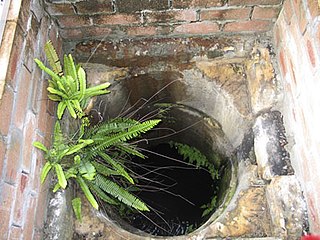
Norfolk Island is an external territory of Australia located in the Pacific Ocean between New Zealand and New Caledonia, 1,412 kilometres (877 mi) directly east of Australia's Evans Head and about 900 kilometres (560 mi) from Lord Howe Island. Together with the neighbouring Phillip Island and Nepean Island, the three islands collectively form the Territory of Norfolk Island. At the 2021 census, it had 2,188 inhabitants living on a total area of about 35 km2 (14 sq mi). Its capital is Kingston.

Protected areas of Australia include Commonwealth and off-shore protected areas managed by the Australian government, as well as protected areas within each of the six states of Australia and two self-governing territories, the Australian Capital Territory and the Northern Territory, which are managed by the eight state and territory governments.

Coffin Bay National Park is a protected area in on the Eyre Peninsula of South Australia, Australia, which is located about 301 km west of Adelaide and about 46 km west of Port Lincoln. The town of Coffin Bay is near the entrance to the national park. The national park occupies the Coffin Bay Peninsula - a long peninsula with a sheltered bay to its north, coastal dunes, swamps and a coastline which overlooks islands, reefs, limestone cliffs and white surf beaches.

Lake Gairdner National Park is a protected area associated with Lake Gairdner in South Australia (Australia), 436 km northwest of Adelaide. It is located just south of the Trans-Australian Railway, Stuart Highway, and the Woomera Prohibited area.
Murray River National Park is a protected area in South Australia located between 180 kilometres (110 mi) and 240 km (150 mi) north east of the Adelaide city centre, lying along the Murray River. The national park is classified as an IUCN Category VI protected area. As of 2022 the national park comprises more than 14,879 ha, and includes a vast network of Murray River wetlands and floodplains.

Kingston is the capital of the Australian external territory of Norfolk Island. The Norfolk Island Regional Council is based in Kingston. The settlement is the second-oldest in Australia, founded a little over a month after Sydney. It is part of the Kingston and Arthur's Vale Historic Area World Heritage Site.

Tasmania Parks and Wildlife Service is the government body responsible for managing protected areas of Tasmania on public land, such as national parks, historic sites and regional reserves. Historically it has also had responsibility for managing wildlife, including game.

Phillip Island is an island located 6 km (3.7 mi) south of Norfolk Island in the Southwest Pacific, and is part of the Norfolk Island group. It was named in 1788 by Lieutenant Philip Gidley King after Arthur Phillip, the first Governor of New South Wales. Phillip Island is part of the Australian external territory of Norfolk Island, and is included in Norfolk Island National Park, as is neighbouring Nepean Island and about 10 percent of Norfolk Island proper.

Australian Convict Sites is a World Heritage property consisting of 11 remnant penal sites originally built within the British Empire during the 18th and 19th centuries on fertile Australian coastal strips at Sydney, Tasmania, Norfolk Island, and Fremantle; now representing "...the best surviving examples of large-scale convict transportation and the colonial expansion of European powers through the presence and labour of convicts".

Kingston and Arthurs Vale Historic Area (KAVHA) is an old settlement on the Kingston coastal plains, southern side of Norfolk Island, consisting of a large group of buildings from the British Empire's convict era (1788–1855), now considered to be of such cultural significance to Australia and to the World that the area has been formally inscribed onto both the Australian National Heritage List and UNESCO's World Heritage list as amongst:
" .. the best surviving examples of large-scale convict transportation and the colonial expansion of European powers through the presence and labour of convicts."

Coal Mines Historic Site was a convict probation station and the site of Tasmania's first operational coal mine, serving for a period of 15 years (1833–1848) "as a place of punishment for the 'worst class' of convicts from Port Arthur".

Darlington Probation Station was a convict penal settlement on Maria Island, Tasmania, from 1825 to 1832, then later a convict probation station during the last phase of convict management in eastern Australia (1842–1850).
Neptune Islands Conservation Park is a protected area occupying most of the Neptune Islands in South Australia about 55 km (34 mi) south-south east of Port Lincoln. It was established in 1967 principally to protect a New Zealand fur seal breeding colony. The conservation park was subsequently expanded to include the adjoining waters in order to control and manage berleying activities used to attract great white sharks. As of 2002, the conservation park is the only place in Australia where shark cage diving to view great white sharks is legally permitted.
Lipson Island Conservation Park is a protected area in the Australian state of South Australia associated with Lipson Island in Spencer Gulf about 12 kilometres north northeast of Lipson.

Cape Willoughby Conservation Park, formerly part of the Cape Hart Conservation Park, is a protected area in the Australian state of South Australia located on the north coast of the Dudley Peninsula on Kangaroo Island in the gazetted locality of Willoughby about 27 kilometres south east of Penneshaw.
Norfolk Islanders, also referred to as just Islanders, are the inhabitants or residents of Norfolk Island, an external territory of Australia. The Islanders have their own unique identity and are predominantly people of Pitcairn and English descent and to a lesser extent of Scottish and Irish.

The Underground Grain Silos are heritage-listed silos at Cockatoo Island, Sydney Harbour, New South Wales, Australia. It was added to the Australian Commonwealth Heritage List on 22 June 2004.

Norfolk Island Museum is a museum organisation on Norfolk Island, an external territory of Australia in the southern Pacific Ocean. The museum comprises five sites and collections that include archaeological, archival and social history objects that reflect subsequent waves of forced migration to the island.














